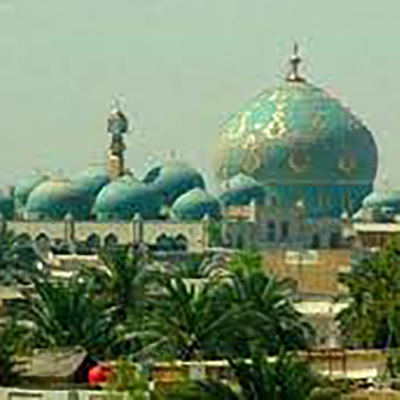Sites
Basra
Written by: Hassan Jafarzadeh
Translated by: Hadi Qorbanyar
9 Views
Basra is a city and governorate in southern Iraq, whose capture was regarded as a strategic lever to end the Iran–Iraq War. It served as the focal point of Iran’s military strategy on the southern fronts.
The Basra Governorate borders the Muthanna Governorate (Samawa) to the west, Iran’s Khuzestan Province to the east, Maysan Governorate (Amarah) to the northeast, Dhi Qar Governorate (Nasiriyah) to the northwest, the Persian Gulf (Al-Faw estuary) to the southeast, and Kuwait to the south and southwest.[1] The governorate covers an area of about 20,702 square kilometers, and its capital is the historic city of Basra. The population of Basra decreased from about 1.5 million in 1977 to less than 900,000 in the years following the Iran–Iraq War during the 1980s. The city was again heavily bombarded during the Persian Gulf War (1991), which began after Iraq’s occupation of Kuwait and the subsequent U.S.-led coalition attack to force its withdrawal, leading to a further population decline. In 2004, Basra’s population was estimated at 1,477,200.[2]
Before the outbreak of the Iran–Iraq War, the Baathist regime in Iraq had turned Basra into a base for separatist elements from Iran’s Khuzestan Province, organizing their military training through the Basra Security Organization before sending them into Iran for sabotage operations.[3] One of the two bases of the Iraqi Navy was also located in the port of Basra.[4]
With the beginning of the war, the Basra region played a major role in the course of the conflict. From the outset, Basra’s strategic facilities were among the main targets of Iranian air strikes. In the early days of the war, and in response to Iraq’s full-scale invasion, Iranian Air Force jets bombed the city’s military centers and oil installations.[5] As a result, Iraq lost access to Basra’s port facilities, its oil exports from the region were significantly reduced, and it came under maritime blockade by Iran.[6] Throughout the Iran–Iraq War, reaching the gates of Basra was the strategic military goal for Iran. The Basra region on the southern front was the most significant operational area that, from the summer of 1982 onward, consistently drew the attention of Iranian military commanders for launching major offensives. Several large-scale operations were planned and carried out in that area.[7]
Following the liberation of Khorramshahr, Iran began its military offensives near Basra with Operation Ramazan (July 1982). Iran aimed to establish its forces on the eastern bank of the Arvand River, take control of Basra, and shape a political and military landscape that would force Iraq to accept its demands.[8] Realizing this objective, the Iraqi army made the defense of Basra the core of its military strategy, thereby constructing the most fortified and complex defensive barriers and concentrating its largest forces in the eastern approaches to the city.[9] The Basra region witnessed several major battles, including operations Ramazan (July 1982), Kheibar and Badr (February 1984 and March 1985), Valfajr 8 (February 1986), Karbala 4 and Karbala 5 (December 1986 and January 1987), Karbala 8 (April 1987), and Ansar al-Hussain (May 1987). All were aimed at advancing toward or gaining control of Basra.[10]
Operation Karbala 5 was the most important of these offensives. It witnessed the fiercest fighting of the entire war right behind Basra’s gates, as Iranian forces advanced to the very edge of the city.[11] Because Iraq had concentrated most of its military strength in the Basra region due to its strategic significance, Iranians succeeded in destroying a significant portion of Iraq’s military power in the region.[12] The breakthrough achieved by Iranian forces in Karbala 5, especially through Iraq’s heavily fortified eastern Basra defenses, triggered major shifts in the course of the war.
Military analysts consider Basra the turning point of the war.[13] As Iranian troops pushed closer to Basra, global pressure mounted on Iran to end the war. The UN Security Council Resolution 598, arms embargo proposals, and the deployment of U.S. troops to the Persian Gulf were among the measures driven by these pressures, all intended to bring the war to a close.[14] Moreover, Iran’s proximity to Basra prompted the two superpowers of the time, the United States and the Soviet Union, to initiate talks in order to prevent further Iranian gains.[15]
After Operation Karbala 5, its complementary action, known as Operation Karbala 8, was launched in April 1987 as Iran’s last major offensive in the Basra region. However, due to the closure of operational routes — resulting from Iraqi alertness and the creation of multiple defensive layers — advancing toward Basra proved impossible. Iran subsequently redirected its operational focus from the southern front to the northwestern sector.[16] After the war ended, reconstruction of Basra — once Iraq’s second-largest city and only seaport — became a priority. The Iraqi government allocated about five billion dollars for the city’s rehabilitation.[17]
[1] Naqshey-e Rahnama-ye Araq (Guide Map of Iraq), Gitashenasi, Tehran, 1376.
[2] Daaerat ol-Maaref-e Bozorg-e Eslami (The Great Islamic Encyclopedia), https://www.cgie.org.ir/fa/article/228820/%D8
[3] Yekta, Hussain, Ruzshomar-e Jang-e Iran va Araq: Peydayesh-e Nezam-e Jadid – Bohran dar Khuzestan (Chronology of the Iran-Iraq War: Emergence of the New Order – Crisis in Khuzestan), Tehran, Markaz-e Motaleaat va Tahqiqat-e Jang, 1377, Pp. 747–768.
[4] Rashid, Mohsen, Aashenaei ba Jang – Gozareshi Kotah (An Introduction to the War – A Brief Report), Markaz-e Motaleaat va Tahqiqat-e Jang-e Sepah-e Pasdaran-e Enqelab-e Eslami, 1380, p. 17.
[5] Ansari, Mahdi, va Hussain Yekta, Ruzshomar-e Jang-e Iran va Araq– Hojum-e Saresari (Chronology of the Iran-Iraq War – The All-out Invasion), Markaz-e Motaleaat va Tahqiqat-e Jang-e Sepah-e Pasdaran-e Enqelab-e Eslami, 1375, Pp. 359–380.
[6] Alaei, Hussain, Ravand-e Jang-e Iran va Araq (The Course of the Iran-Iraq War), Vol. 1, Tehran, Nashr-e Marz va Boum, 1391, Pp. 243–244.
[7] Ardestani, Hussain, Tajziye va Tahlil-e Jang-e Iran va Araq– Tanbih-e Motajavez (Analysis of the Iran-Iraq War – Punishment of the Aggressor), Vol. 3, Markaz-e Motaleaat va Tahqiqat-e Jang-e Sepah-e Pasdaran-e Enqelab-e Eslami, 1379, p. 231.
[8] Ibid., p. 33.
[9] Dorri, Hassan, Rahbord-e Amaliyat-e Mahdud-e Iran pas az Amaliyat-e Ramazan (Iran’s Limited Operations Strategy after Operation Ramazan), Faslnamey-e Negin-e Iran, Vol. 10, No. 37, 1390, p. 28.
[10] Rashid, Mohsen, Aashenaei ba Jang – Gozareshi Kotah (An Introduction to the War – A Brief Report), Markaz-e Motaleaat va Tahqiqat-e Jang-e Sepah-e Pasdaran-e Enqelab-e Eslami, 6th ed., 1380/1382, Pp. 43–72.
[11] Soudaagar, Ahmad, 10 Qatnameh baraye 8 Sal-e Defa Muqaddas (Ten Resolutions for Eight Years of the Sacred Defense), Vije-nameh-ye Salrooz-e paziraesh-e Qatnameh-ye 598, 1389, p. 21.
[12] Jamshidi, Muhammad-Hussain, va Mahmoud Yazdanfam, Ruzshomar-e Jang-e Iran va Araq– Akharin Talashha dar Jonub (Chronology of the Iran-Iraq War – The Last Efforts in the South), Vol. 47, Tehran, Markaz-e Motaleaat va Tahqiqat-e Jang-e Sepah-e Pasdaran-e Enqelab-e Eslami, 1381, Pp. 122–123.
[13] Doroudian, Muhammad, Seiri dar Jang-e Iran va Araq– Payan-e Jang (A Study of the Iran-Iraq War – The End of the War), Vol. 5, Markaz-e Motaleaat va Tahqiqat-e Jang-e Sepah-e Pasdaran-e Enqelab-e Eslami, 1378, p. 23.
[14] Ardestani, Hussain, Ibid., p. 390.
[15] Mokhtari, Majid, Barrasi-ye Tahavolat-e Nezami-ye Iran va Araq dar Maqtae Payani-ye Jang (A Study of Iran and Iraq’s Military Developments in the Final Phase of the War), Faslname-ye Motaleaat-e Jang-e Iran va Araq, Vol. 2, No. 6, 1392, p. 16.
[16] Ardestani, Hussain, Ibid., Pp. 288–301.
[17] Robbins, Philip, Ahdaaf, Esterateji-ha va Moshkelat-e Araq dar Jang (Iraq’s Goals, Strategies, and Problems in the War), Grouh-e Tarjome, Mahnamey-e Negah, Vol. 3, No. 26, Shahrivar 1381, p. 52.





